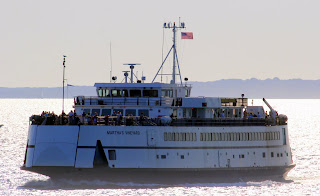[Photo: the Martha's Vineyard ferry passes through Nantucket Sound, west of the Cape Wind site]
Right in the executive summary, the DPU presents its key finding: "that the Cape Wind contract is both cost-effective and in the public interest." As I read through the DPU's order, I was interested to see how the Department analyzed the facts to reach this finding. While the order resembles those approving contracts between utilities and more traditional generators, it diverged from these precedents in key ways including an analysis of how the contract would support the Commonwealth's renewable power standard and environmental goals.
For example, summarizing its analysis of cost-effectiveness, the DPU stated:
As we have said, the price of the Cape Wind contract is $187 per MWh for 15 years, with a 3.5 percent annual escalator and opportunities for both upward and downward price adjustments depending on a variety of contingencies. Contrary to the assertions of some parties in the case, there are no additional transmission costs to customers beyond those that are already included in the contract price, and no costs of any significance to back up the addition to the regional electricity grid of an intermittent resource the size of Cape Wind.
On the other side of the ledger, the benefits associated with the Cape Wind contract include the value associated with the energy, capacity, and renewable energy credits that National Grid will purchase through the contract. In those years when the contract cost exceeds that value, National Grid customers will pay “above-market costs” for the Cape Wind contract. Based on the evidence presented, we believe the most likely range of above-market costs over the 15 years of the contract, including consideration of the price suppression effect, is from $420 million to $695 million.Thus the DPU asserts that over the life of the contract, National Grid's ratepayers will most likely pay $420 million to $695 million in above-market costs.
Another interesting section of the order was where the DPU found that this contract was cost-effective by comparison to other offshore wind projects. During the case, the Attorney General and Cape Wind each provided analyses comparing the costs and prices of the Cape Wind facility to a variety of operating and planned offshore wind projects here and abroad. Both the Attorney General and Cape Wind compared the power purchase agreement to that between Delmarva Power & Light Company and Bluewater Wind Delaware LLC for the output of its 200 MW offshore wind facility off Delaware. Analysis was also offered by the AG of the Deepwater Block Island LLC contract (28.8 MW proposed off Rhode Island) and (2) a un-named "domestic offshore wind project" whose information is protected by confidentiality.
After analysis, the DPU stated, "The various analyses performed by the Attorney General and Cape Wind demonstrate that the price terms of PPA-1 are reasonable compared to proposed offshore wind projects in the United States and to existing and proposed offshore wind projects abroad." The Order then compared Cape Wind's levelized price of $230 to the Bluewater levelized price of $230 and the Deepwater Block Island levelized price of $340.
Intuitively, that Deepwater came in with a higher price makes some sense. As the AG pointed out in the Cape Wind case, the nameplate capacity of the 28.8 MW project is just 6% of the capacity of Cape Wind's 468 MW, "presumably providing the Deepwater Block Island facility with fewer economies of scale".
If the Cape Wind order serves as precedent establishing the framework within which future renewable PPAs must fit, we have a lot to learn from the analysis in its 374 pages. Offshore wind developers and others interested in renewable projects who fit their projects into this framework may be better poised for regulatory approval.



No comments:
Post a Comment